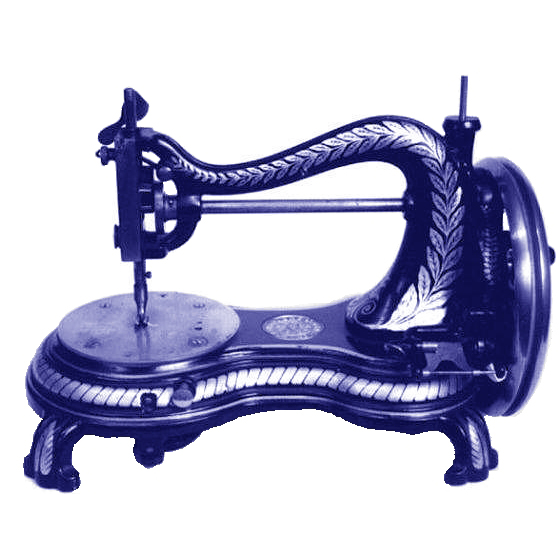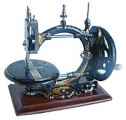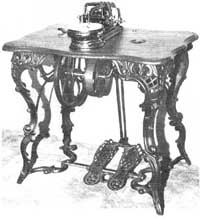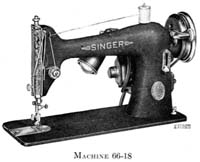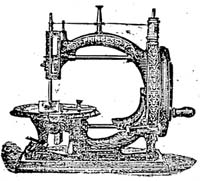Chimonnier, Inventor of the Sewing Machine
It took some considerable time before Thimonnier was eventually given credit for his invention and its merits were debated fiercely. On October 1st, 1881, The Sewing Machine Gazette reported a French correspondent putting the record straight. The curious spelling of the surname is as it appeared.
In the current edition of La Machine à Coudre (The Sewing Machine), 'A Veteran' writes from Paris: Some time ago you dedicated an article to the memory of Elias Howe. Will you now permit me to speak some words about our countryman Chimonnier?
Elias Howe, you remembered, died at the pinnacle of glory. Chimonnier died in poverty, almost unknown. Thirty years of struggle, of labour, of misery, had exhausted him. He died miserably. And yet he is the man, and he alone, who can claim the honour of having, constructed the first sewing machine, sewing in a practicable manner (Brevet of 17 April 1830) and instead of being, at his death-bed, in the possession of the cross of the Legion d'Honneur, that he had really deserved, he left this world as a martyr of his discovery; leaving his family in the utmost indigence.
Elias Howe was a mechanician. Chimonnier understood nothing of the first elements of mechanics; he spends four years in working very little in his workshop, that gives bread to his family, and very much in an isolated pavilion, without anyone knowing what he is about. He neglects his business, loses his credit, ruins himself, is even treated as a madman, but he never minded it. In 1820 he has at length embodied his idea, he has invented a new instrument, the sewing machine.
Chimonnier did not only suffer under the disdain his new invention met with, he saw not only his life menaced, escaping only by flight from the hands of the workmen of the house Germain, Petit et Co., (11 July, 1831), but even the press declared itself against him.
Your readers may follow here some passages from the Journal de Villefranche, No. 213, September 14, 1845.
Letter of a subscriber:
"You publish, in the most flattering terms, the invention of a sewing machine, due to the sagacious meditations of Mr. Chimonnier, tailor, at Amplepuis. You are quite right in. saying that this machine is destined to produce a revolution in the sewing industry, and it is justly this revolution which I consider as the source of the most fatal consequences, etc….."
… follows a picture of the deplorable destiny of women, if the sewing machine were to become of general use, the writer of the letter concludes thus:
"In every respect, even in matters of progress, the good, when it is counterbalanced by a greater evil, must he shun as a public calamity. If, on one hand, the sewing machine is to introduce some ameliorations, it needs produce on the other fatal results. I therefore cannot agree with the praises, which you bestow on the inventor, still less am I inclined to wish for its propagation, unless the numerous and interested class of the seamstresses be gifted with another industry."
The editor added a note to this letter, in which he excuses himself for having given to understand, that he considered the machine a benefit. He ends by saying,
"In announcing the invention of the sewing machine, we could foresee that it would produce a revolution in this industry, but in evincing this supposition, we abstained from examining what would be the other consequences to result from this invention. We wished but to render homage to the merits of the inventor."
If Chimonnier did, nevertheless, construct the first machine, he was no less eloquent in refuting the attacks of his opponents in a letter, in which he gives proofs of a very positive and logical spirit. I regret its being too long to be inserted here. I will nevertheless reproduce the conclusion, where he says - after having quoted the example of the weaver's loom and the spinner's wheel, the ground basis of the prosperity of the principal cities on the Rhone –
"The workman who opposes himself against the machine is like a child that revolts against and ill-uses his nurse. What is my sewing machine, compared to all those sublime inventions, that it should deserve such attacks? What is its destiny? I am unaware.
But if it were permitted to me to expect from it for the confection of dress and linen-cloth of each person a yearly benefit of one franc, I would have saved my country a yearly labour of thirtythree million francs; which, added to the benefits of other industries, would considerably augment the nations wealth without calculating the profits derived from the exportation.
And every unfortunate individual would gain yearly the produce of one day's labour. Such a result, the most flattering reward which I can wish for, would amply console me for the attacks, respectable in their meaning but erroneous, directed against my invention."
I will conclude by refuting an error spread amongst the public, that the machine constructed by Chimonnier was of wood.
I had the honour, some time ago, to pay a visit to Mr. E. Chimonnier, the son of the inventor, who, with great affability and perfect good grace, showed me one of the first essays of his father's invention.
He made me observe that iron, steel and copper entered in its construction. He put into operation a machine sold by his father to a tailor in 1840, and re-built by him in 1872. This machine, after thirty-two years of service, acted still very well. It makes a stitch at every turn of the pedal (about 200 a minute). The needle is with crotchet point, the thread-bobbin is underneath, an iron filament brings the thread against the crotchet, which in rising brings the thread in the stuff, where it forms a curl; the crotchet re-descending, traverses the curl, so that the chain is formed thereon. The enchaining is very regular and the length of the stitch is regulated by a screw.
The `Sewing Machine Gazette and Journal of Household Appliances, Oct. 1st, 1881
